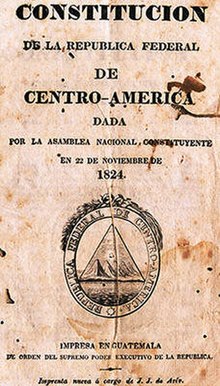You can help expand this article with text translated from the corresponding article in Spanish. (April 2024) Click [show] for important translation instructions.
|
The constitution of the Federal Republic of Central America (Spanish: constitución de la República Federal de Centro América) was the governing document of the Federal Republic of Central America from 1824 to 1839. It was inspired by both the United States Declaration of Independence and the Spanish Constitution of 1812
| Constitution of the Federal Republic of Central America | |
|---|---|
 | |
| Overview | |
| Jurisdiction | Federal Republic of Central America |
| Created | 12 June 1824 |
| Presented | 4 July 1824 |
| Ratified | 22 November 1824 |
| System | Federal presidential republic |
| Government structure | |
| Branches | 3 |
| Chambers | Bicameral |
| Executive | President |
| Judiciary | Supreme Court |
| Federalism | Federation |
| Electoral college | Yes |
| First legislature | 6 February 1825 |
| First executive | 29 April 1825 |
| First court | 29 April 1825 |
| Repealed | 17 April 1839 |
| Location | Guatemala City, Guatemala |
History
editOn 1 July 1823, Central America declared its independence from Mexico after having been a part of Mexico since January 1822.[1] The political leaders who declared independence from Mexico established the National Constituent Assembly, and the assembly was tasked with drafting a constitution for the newly independent United Provinces of Central America (later named the Federal Republic of Central America).[2]
On 28 June 1824, the National Constituent Assembly drafted the country's constitution. It was published on 4 July,[3] and on 22 November, the assembly officially ratified the constitution.[4] The constitution was repealed upon the dissolution of the Federal Republic of Central America on 17 April 1839.[5]
Contents
editThe constitution established a federal government composed of a legislative, executive, and judicial branch. All officials in these branches were elected through indirect elections.[6] The legislative branch consisted of the Federal Congress (itself composed of the Senate and the Council of Deputies);[7] the executive branch consisted of the president, the vice president, and the cabinet;[8] and the judicial branch consisted of the Supreme Court.[9] The constitution granted most of the federal government's power, including the executive power, to the Federal Congress; American historian William F. Slade described the federal government established by the constitution as a "parliamentary dictatorship".[10]
Historical assessment
editThe Central American constitution was loosely based on the United States federal government, the United States Declaration of Independence, and the 1812 Spanish constitution.[11] Central American historians have criticized the constitution as being "too idealistic", and cited this as a contributing factor to the collapse of the Federal Republic of Central America.[12]
References
editCitations
edit- ^ Foster 2007, p. 136.
- ^ Slade 1917, p. 89.
- ^ Meléndez Chaverri 2000, p. 286.
- ^ Luján Muñoz 1982, p. 83.
- ^ Marure 1895, p. 114.
- ^ Ching 1997, pp. 48–50.
- ^ Karnes 1961, p. 6.
- ^ Marure 1895, p. 136.
- ^ Marure 1895, p. 56.
- ^ Slade 1917, p. 98.
- ^ Karnes 1961, pp. 45–46 & 49.
- ^ Karnes 1961, p. 51.
Bibliography
edit- Ching, Erik K. (1997). From Clientelism to Militarism: The State, Politics and Authoritarianism in El Salvador, 1840–1940. Santa Barbara, California: University of California, Santa Barbara. OCLC 39326756. ProQuest 304330235. Retrieved 25 April 2024.
- Foster, Lynn V. (2007). A Brief History of Central America (2nd ed.). New York City: Facts on File. ISBN 9780816066711. OCLC 72161924. Retrieved 25 April 2024.
- Karnes, Thomas L. (1961). The Failure of Union: Central America, 1824–1960. Chapel Hill, North Carolina: University of North Carolina Press. ISBN 9780807808160. OCLC 484694. Retrieved 25 April 2024.
- Luján Muñoz, Jorge (1982). "La Asamblea Nacional Constituyente Centroamericana de 1823-1824" [The Central American National Constituent Assembly of 1823–1824]. The American Historical Review (in Spanish) (94). Pan American Institute of Geography and History: 33–89. ISSN 0034-8325. JSTOR 20139471. OCLC 9983608349.
- Marure, Alejandro (1895). Efemérides de los Hechos Notables Acaecidos en la República de Centro-América Desde el Año de 1821 Hasta el de 1842 [Ephemeris of the Notable Events that Occurred in the Republic of Central America from the Year 1821 to that of 1842] (in Spanish). Central America: Tipografía Nacional. OCLC 02933391. Retrieved 25 April 2024.
- Meléndez Chaverri, Carlos (2000). José Matías Delgado, Prócer Centroamericano [José Matías Delgado, Central American Hero] (in Spanish). Vol. 8 (2nd ed.). San Salvador, El Salvador: Dirección de Publicaciones e Impresos. ISBN 9789992300572. OCLC 1035898393. Retrieved 25 April 2024.
- Slade, William F. (July 1917). "The Federation of Central America". Journal of Race Development. 8 (1). Worcester, Massachusetts: 79–150. doi:10.2307/29738226. JSTOR 29738226. OCLC 7961547.
External links
edit- "Constitución de la República Federal de Centro América, Decretada por la Asamblea Nacional Constituyente en 22 de Noviembre de 1824" [Constitution of the Federal Republic of Central America, Decreed by the National Constituent Assembly on 22 November 1824] (PDF). National Constituent Assembly of Central America (in Spanish). 22 November 1822. Archived from the original (PDF) on 24 September 2015. Retrieved 25 April 2024.